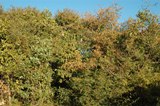Weaver news
|
Abstract. The Nelicourvi Weaver Ploceus nelicourvi is endemic to Madagascar and information on its breeding biology is scarce and fragmentary. The behavior and parental care of the Nelicourvi Weaver were investigated in Maromizaha Park, eastern Madagascar, from November 2009 to January 2010. We found three nests located 250–700 m apart, suspended 3–10 m above the ground from branches of Nastus spp. (Poaceae) and Trema orientalis (Ulmaceae) above open areas such as streams or trails. The nests were bulky woven structures each with an extended entrance tunnel (ca. 14 cm long). Over a period of about 12 days, the males built the nest structures and the females contributed the nest lining material. The female alone incubated the eggs for about 15 days, and undertook most of the brooding of the young, with only some assistance from the male. During the nestling period, which lasted 13–25 days, both sexes delivered food (mainly beetles, grasshoppers, caterpillars and occasionally small chameleons) to the nestlings. These results suggest that the Nelicourvi Weaver is a socially monogamous bird.
About 30 weavers in the Ploceinae subfamily are monogamous, and in these there is usually little or no sexual dimorphism. For instance, male and female Dark-backed Weavers are similar, while in Spectacled Weavers the sexes are similar but the male has a black bib. In the Nelicourvi Weaver, the sexes are distinguishable as the male has a black cap and mask but in the female the yellow head has grey/olive patches. The amount of variation in parental care and sexual dimorphism in monogamous weavers, including the Nelicourvi Weaver, needs to be studied further. Photos: top - male (source phown 862 and right - female (source phown 920. All PHOWN records, and a summary of breeding information, for this species may be viewed here. |











 Rakotomanana H, Nakamura M. 2012. Breeding ecology of the Malagasy endemic Nelicourvi Weaver Ploceus nelicourvi.
Rakotomanana H, Nakamura M. 2012. Breeding ecology of the Malagasy endemic Nelicourvi Weaver Ploceus nelicourvi. 